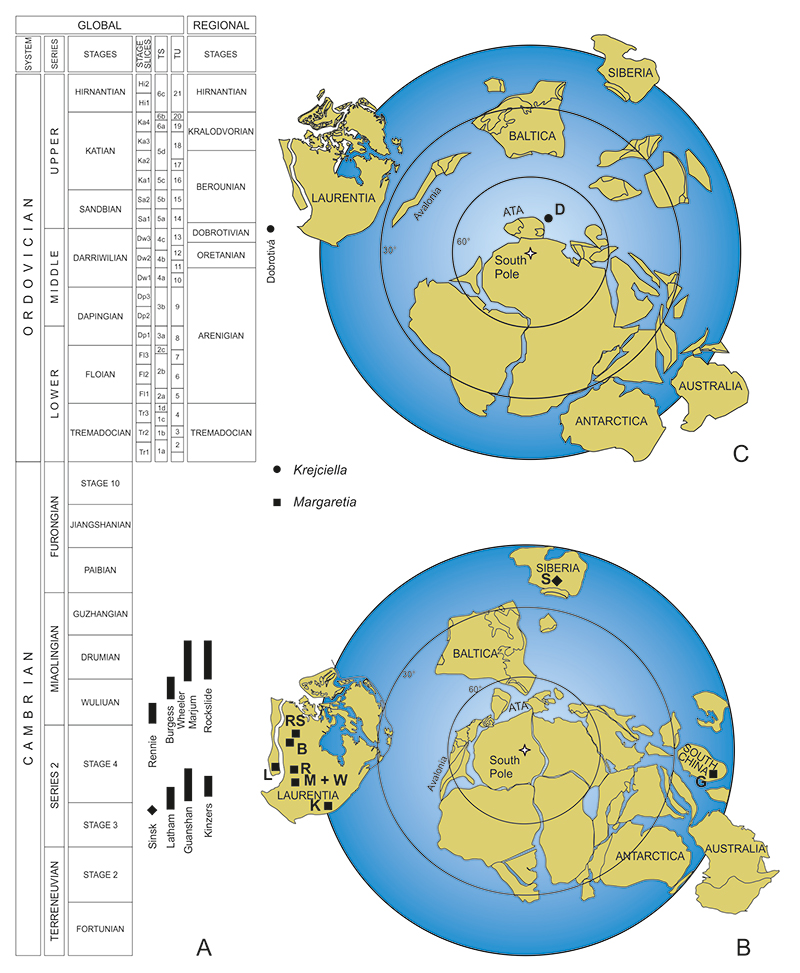FIGURE 1. Location map of the study area, showing the location of each of the studied localities within the Ordovician of the Prague Basin. A. Map of the Czech Republic and the Bohemian Massif showing the distribution of Ordovician rocks in the Prague Basin. B. Ordovician of the Prague Basin with the location of five outcrops that yielded the studied specimens.

FIGURE 2. Type material of Krejciella putzkeri Obrhel 1968. Three-dimensionally preserved fragments of tube-shaped fossils. All specimens are in lateral view and are housed in the National Museum Prague. A. Holotype, NML D497a. B. Counterpart of the holotype, NML 497b. C. Paratype, NML 498.

FIGURE 3. Other material of Krejciella putzkeri Obrhel 1968. Flattened fragments of tube-shaped fossils. White arrows indicate fibres. A. External mould, ČGS JP2015a. B. ČGS JP 2016b detail of pores. C. Internal mould, ČGS JP2015b. D. Internal mould, ČGS JP2016a. E. Internal mould, ČGS JP2017.

FIGURE 4. Sketch showing the distribution of major biofacies associated with the late Darriwilian-early Sandbian Dobrotivá Formation. The shallowest part of the basin was inhabited by a sparse orthid brachiopod association. In the offshore direction it was replaced by the Placoparia Association, which is characterized by a rich skeletal fauna with trilobites and brachiopods. In the offshore slope settings, it grades into a low-diversity atheloptic trilobite association that also includes ‘gardens’ of benthic dendroids. The water column was inhabited by planktonic graptolites and taxa of the poorly diverse Cyclopygid Biofacies, particularly by Degamella princeps. Poorly oxygenated black shales in the central part of the basin were dominated by the Paterula Association, at some sites associated with the trilobite Zeliszkella oriens. Modified after Fatka and Mergl (2009, figure 11d) and Peršín and Budil (2009).

FIGURE 5. Distribution of tubiculous fossils classified as Margaretia in the middle Cambrian and specimens of Krejciella in the Middle Ordovician. A. Stratigraphic ranges of tubiculous fossils in Cambrian and Ordovician. B. Palaeogeographical reconstruction of the middle Cambrian. C. Palaeogeographical reconstruction of the Middle Ordovician. Palaeogeography modified after Cocks and Torsvik (2002, 2011), Fatka and Mergl (2009) and Torsvik and Cocks (2013). B - Burgess Lagerstäte. D - Dobrotivá Lagerstäte. G - Guanshan Lagerstäte. K - Kinzers Lagerstäte. L - Latham Lagerstäte. M - Marjum Lagerstäte. RS - Rockslide Formation Lagerstäte. S - Sinsk Lagerstäte. R - Rennie Lagerstäte. W - Wheeler Lagerstäte.

FIGURE 6. Chitinozoans from the Dobrotivá Formation. A-G SEM photographs of chitinozoans from the sample No. ČGS JP2016a. K-M Photographs taken in transmitted light of chitinozoans from the Cekov HJ 1 drill core. A. ? Cyathochitina sp. A, Krej1_S4-7451. B. ? Cyathochitina sp. A, Krej1_S1-7140. C. Euconochitina ? vulgaris, Krej1_S2-7184. D. Linochitina pissotensis, Krej1_S4-7464. E. ? Eremochitina sp. indet., Krej1_S3-7430. F. ? Cyathochitina sp. A, Krej1_S2-7251. G. ? Cyathochitina sp. A, Krej1_S2-7267. H. Desmochitina e x. gr. minor, Krej1_S2-7220. I. Linochitina pissotensis, Krej1_S2-7194. J. Linochitina pissotensis, Krej1_S4-7468. K. Linochitina pissotensis, Cekov HJ1_391. L. Linochitina pissotensis, Cekov HJ1_463. M. Linochitina pissotensis, Cekov HJ1_436. Scale bars in μm. Samples are housed as permanent slides in the Czech Geological Survey.

FIGURE 7. Size variation of Linochitina pissotensis. Green dots = the herein studied sample. Blue squares = Cekov HJ 1 drill core, Dobrotivá Formation (Fatka et al., 1997). Red crosses = Kazín section, Letná Formation (Vodička and Fatka, 2017). Grey triangles = type material (Paris, 1981). Black triangle = holotype (Paris, 1981).


